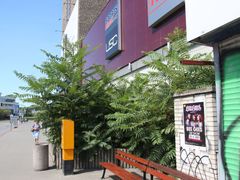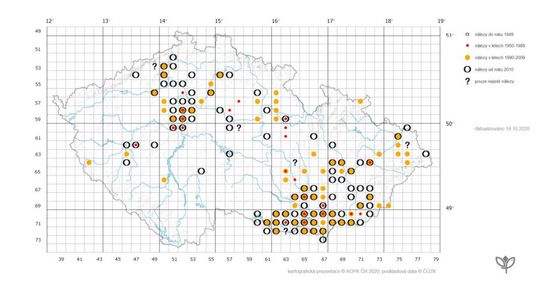The state’s fight against invasive plant species is entering a new phase. The environment ministry has issued instructions on taking action against dangerous bolshinik and bajasan. They usually grow in people’s gardens, and those who do not remove them are fined ten thousand. Be careful when removing. All it takes is a little inattention, and the plant spreads further, or a person can become seriously ill.
No herb in Europe is taller than the magnolia. Although it originates from the Western Caucasus, it is very successful in the Czech Republic. It grows up to five meters, so it can hang over surrounding trees. It also has irresistible flowers – they grow radially on long stems and reach 80 centimeters in diameter. However, the impressive-looking plant brings danger. It displaces native species from the Czech landscape – and is highly poisonous.
Scientists compare Bolshevik extract to mustard gas used in World War I. If someone touches it on the skin it can cause serious injury. When the affected areas are exposed to sunlight, painful blisters appear and the sap begins to erode the skin. In addition, wounds are difficult to heal and leave scars.
At the beginning of August this year, the Ministry of the Environment published instructions on how to remove dangerous plants that do not belong in the Czech Republic. Along with the Bolsheviks, it also focused on the Iron Clown. These are the first steps in authorities’ fight against dozens of invasive species. “Bolshevik has become one of the top ten species attacking Europe. That’s why we are trying to eradicate it completely,” says Petr Hladík, Environment Minister of the KDU-ČSL.
Bolshevnik retreats from the mainland
Bolševník reached Czech territory in the 19th century, where it began to be planted in greenhouses and gardens as an ornamental plant. By the middle of the 20th century, when news of its harm began to spread, it was already too late. After all, it was enough to form dense forest-like stands in western Bohemia around Marianske Lazne. In 2005, it occupied a fifth of some parts of the Slavkovsky Forest. But it grew throughout the Czech Republic.
Liquidation is complicated. After simply being cut, hollyhock will regrow from the root, and the seeds will ripen even in wilted flowers left on the ground. Because of the size of boxwood in the landscape, digging up the roots and burning the plant after drying is laborious and time-consuming.
Bolshevik expansion into the Czech Republic by August 2023 | Photo: AOPK
However, in recent years, its range has been shrinking, points out John Bergl of the Academy of Sciences’ Department of Invasion Ecology, co-author of the newly published ministerial guidelines. Each year, state, local, and municipal governments donate millions of crowns to hogweed removal using proven methods. “Also, people spread the word about how dangerous the plant is,” says Bergl.
Over the next six years, officials want to eliminate the population that spreads the most seeds. Mainly via roads, railways or waterways.
It is more effective to use herbicides, i.e. products that kill plants, over large areas. Focusing only on the bolshevnik is preferable. They are sprayed on the spot at the appropriate time – that is, in May, when the plants are well passable and the plants are only half a meter tall.
“The situation is more complicated where the farmer practices organic farming and the use of herbicides is not allowed,” Berkle warns. There, manual cutting or grazing of the plant is provided by animals. But this should be repeated several times during the season.
It is better to dig up the root. But it also has its own rules. About five to 15 centimeters underground, the root should be cut below its neck. Gloves, waterproof clothing and face protection are required due to the venomous sap. Best in spring, when the plant has minimal sap. In late summer and autumn, it is also possible to cut the flowers and remove the entire plant until spring. Burn the seeds.
Anyone who does not remove the Bolsheviks in the garden faces a fine. “The introduction, release or spread of invasive species can be assessed as a crime against a natural or legal person and can be fined up to 10,000 crowns or one million,” says Lucie Jestokova, spokesperson for the ministry. environment.
Do not cut Bajasan yourself
While Polshen is starting to back down, the case of Bajasan, the other plant targeted by the ministry, is different. Although this deciduous tree is native to China and Vietnam, it is easily confused with ash. In the Czech Republic, it mainly spread in southern Moravia, but in recent years it has reached Prague and northern Bohemia.

Iron Bajasan | Photo: Botanical Institute of the Academy of Sciences of the Czech Republic
“Until recently, it wasn’t on any invasive species list. It would be great if there was more action against it. It’s an underestimated threat,” says Bergl of the Academy of Sciences. In contrast to the hollyhock, it is a tree – that is, a very popular type of plant. Its cutting often disturbs people, and the removal of healthy bajasan trees in May, for example, upsets residents of the Pod Oborou housing estate in Boskowicz, he pointed out. Daily.
Bajashan can also destroy natural ecosystems and encroach on valuable territories. Additionally, its pollen is highly allergenic and contact with the tree can cause dermatitis.

Extent of Bajaj according to Nature and Landscape Conservation Agency database (as of October 2020) | Photo: AOPK
Like lice, it is difficult to get rid of. Careless approach can lead to further spread of the plant. “If you cut it, it puts all that energy into the roots and making shoots,” says Berkle.
So the tree needs to be drilled and the herbicide injected. After that, wait for it to die and only then cut the bhajasan. This is why Berklee does not recommend that people try to remove the Asian tree themselves first. Instead, the concerned environmental department should be contacted.
Video: Invasive species are a big problem, climate change is helping them, says entomologist (29/08/2022)
“When an invasive species proliferates, you have no chance to remove it, only to limit it. Each species has a special story behind it,” says entomologist Jiri Skuhrovek. | Video: Michael Roschipal